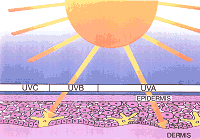Chapter
4
The Tanning Process
� Melanocytes
� Tyrosine
� Melanin
� Immediate pigment darkening
� Delayed tanning
It is essential that you and your employees understand the biological
process by which the skin tans when exposed to ultraviolet radiation.
An understanding of the tanning process will aid you in educating your
clients in the proper way of achieving the best tan possible.
Skin Absorption
Human skin is composed almost entirely of water and organic molecules.
Molecules of organic compounds consist of nuclei which are in relatively
fixed positions and electrons which are found in defined volumes surrounding
the molecular structure. For each compound, certain electronic states
exist, each of which corresponds to the distribution of electrons around
the nuclei and a specific energy. At room temperature, all molecules are
in the electronic state with the lowest energy, called ground state.
UV radiation must first be absorbed by molecules to cause any chemical
change. Only that radiation absorbed by the skin can initiate a biologic
response. A molecule that absorbs light is called a chromophore. These
include molecules such as DNA, RNA, and proteins. After absorbing the
energy of the radiation, the molecule is in an excited state. The molecule
exists in this excited state for a fraction of a second before losing
the energy at which time a chemical change occurs. The observable effect
may be increased pigmentation of the skin or erythema.
The Tanning Process
To understand the tanning process one first needs to realize that the
skin is comprised of several different types of cells. Each type of cell
has a specific function. The cells involved primarily in the tanning process
are called melanocytes. Melanocytes are located at the base of
the epidermis between the epidermis and the dermis below. Melanocytes
use the amino acid tyrosine to produce melanin. This melanin
leaves the melanocytes and travels up through the epidermis where it reacts
with the UVA and UVB radiation through a chemical reaction darkening the
pigmentation of the skin. As we already know the skin consists of three
layers of tissue: The epidermis or outer layer, the dermis or inner layer
and the subcutaneous layer.
 The tanning process or increased pigmentation occurs in two phases. The
first one is immediate pigment darkening (IPD). IPD is a rapid
darkening of the skin which begins during exposure to UV radiation and
its maximum effect is visible immediately. It is caused by a change in
melanin already present in the skin. IPD is most obvious in skin where
significant pigmentation already exists. It occurs after exposure to the
longer wavelength of UVA or visible light. IPD may fade within minutes
of small exposures or may last several days after longer exposures and
blend in with delayed tanning.
The tanning process or increased pigmentation occurs in two phases. The
first one is immediate pigment darkening (IPD). IPD is a rapid
darkening of the skin which begins during exposure to UV radiation and
its maximum effect is visible immediately. It is caused by a change in
melanin already present in the skin. IPD is most obvious in skin where
significant pigmentation already exists. It occurs after exposure to the
longer wavelength of UVA or visible light. IPD may fade within minutes
of small exposures or may last several days after longer exposures and
blend in with delayed tanning.
Delayed tanning, induced mostly by UVB exposure, is the result
of increased epidermal melanin and first becomes visible 72 hours after
exposure. Both UVA and UVB radiation start delayed tanning by creating
an excited condition in the melanocytes which in turn releases more melanin
into the skin. The degree of IPD is primarily a reflection of the person's
skin type. Delayed tanning demands larger doses of both UVA and UVB for
any given response.
|